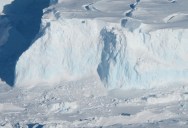Scientists Have Created A Hail Mary Plan To Try To Insulate A “Doomsday” Glacier, But It’ll Cost $50 Billion

Scientists have been issuing warnings about the imminent effects of climate change for decades that have only gotten more dire.
Which could be why this wild plan to try to stop a “doomsday” glacier sounds as desperate as it is expensive.
The glacier in question is the Thwaites “Doomsday” glacier. It’s about the size of Florida and contains so much water that it’s melting will result in sea levels rising two whole feet.
All on its own.

That’s why geoengineers and glaciologists at the University of Lapland in Finland, led by John Moore, have proposed this somewhat outlandish plan to prevent it from melting in the first place.
They want to surround it with huge, 62-mile-long curtains to block the warming water from getting in.
Moore estimates the costs of such a project at around $50 billion.
“It sounds like a heck of a lot. But compare the risk-risk: the cost of sea-level protection around the world, just coastal defenses, is expected to be about $50 billion per year per meter of sea level rise.”
Previously, Moore proposed building a wall in the Amundsen Sea to divert warm currents. Recently, though, he thinks these “seabed anchored curtains” because they’re cheaper and easier to reverse.
“Any intervention should be something that you can revert if you have second thoughts.”
They’re currently testing a three-foot-long prototype in water tanks. Soon, they’ll scale up to a 33-foot-long curtain in the Norwegian fjord.
“We want to know, what could possibly go wrong? And if there’s no solution for it, then in the end, you just have to give up. But there’s also a lot of incentive to try to make it work.”
Other scientists have argued this is merely a band-aid and it distracts from solving the actual problem of rising ocean temperatures.

Moore doesn’t see it that way, though. He doesn’t believe we will be able to reduce emissions quickly enough to save the ice sheet.
Research backs him up, showing massive cracks in the Thwaites glacier that will likely accelerate its melting and collapse.
“The glacier doesn’t really care anymore about what humans want to do about their emissions. At that point, that’s when you need these other tools in the box.”
It’s not very comforting to hear that top scientists worry the point of no return has come and gone.
But at least they haven’t given up entirely.
If you thought that was interesting, you might like to read a story that reveals Earth’s priciest precious metal isn’t gold or platinum and costs over $10,000 an ounce!

Sign up to get our BEST stories of the week straight to your inbox.




